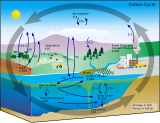
| Part of a series on the |
| Carbon cycle |
|---|
 |
Particulate organic matter (POM) is a fraction of total organic matter operationally defined as that which does not pass through a filter pore size that typically ranges in size from 0.053 millimeters (53 μm) to 2 millimeters.[3]
Particulate organic carbon (POC) is a closely related term often used interchangeably with POM. POC refers specifically to the mass of carbon in the particulate organic material, while POM refers to the total mass of the particulate organic matter. In addition to carbon, POM includes the mass of the other elements in the organic matter, such as nitrogen, oxygen and hydrogen. In this sense POC is a component of POM and there is typically about twice as much POM as POC.[4] Many statements that can be made about POM apply equally to POC, and much of what is said in this article about POM could equally have been said of POC.
Particulate organic matter is sometimes called suspended organic matter, macroorganic matter, or coarse fraction organic matter. When land samples are isolated by sieving or filtration, this fraction includes partially decomposed detritus and plant material, pollen, and other materials.[5][6] When sieving to determine POM content, consistency is crucial because isolated size fractions will depend on the force of agitation.[7]
POM is readily decomposable, serving many soil functions and providing terrestrial material to water bodies. It is a source of food for both soil organisms and aquatic organisms and provides nutrients for plants. In water bodies, POM can contribute substantially to turbidity, limiting photic depth which can suppress primary productivity. POM also enhances soil structure leading to increased water infiltration, aeration and resistance to erosion.[5][8] Soil management practices, such as tillage and compost/manure application, alter the POM content of soil and water.[5][6]
- ^ Monroy, P., Hernández-García, E., Rossi, V. and López, C. (2017) "Modeling the dynamical sinking of biogenic particles in oceanic flow". Nonlinear Processes in Geophysics, 24(2): 293–305. doi:10.5194/npg-24-293-2017.
 Material was copied from this source, which is available under a Creative Commons Attribution 3.0 International License.
Material was copied from this source, which is available under a Creative Commons Attribution 3.0 International License.
- ^ Simon, M., Grossart, H., Schweitzer, B. and Ploug, H. (2002) "Microbial ecology of organic aggregates in aquatic ecosystems". Aquatic microbial ecology, 28: 175–211. doi:10.3354/ame028175.
- ^ Cambardella, C. A.; Elliott, E. T. (1991). "Particulate soil organic-matter changes across a grassland cultivation sequence". Soil Science Society of America Journal. 56 (3): 777–783. doi:10.2136/sssaj1992.03615995005600030017x.
- ^ Moody, C.S. and Worrall, F. (2017) "Modeling rates of DOC degradation using DOM composition and hydroclimatic variables". Journal of Geophysical Research: Biogeosciences, 122(5): 1175–1191. doi:10.1002/2016JG003493.
- ^ a b c Brady, N. C.; Weil, R. R. (2007). The nature and properties of soils (11th ed.). Upper Saddle River, NJ: Prentice-Hall Inc.
- ^ a b Gregorich, E. G.; Beare, M. H.; McKim, U. F.; Skjemstad, J. O. (2006). "Chemical and biological characteristics of physically uncomplexed organic matter". Soil Science Society of America Journal. 70 (3): 975–985. Bibcode:2006SSASJ..70..975G. doi:10.2136/sssaj2005.0116.
- ^ Carter, M. R. (1993). Soil Sampling and Methods of Analysis. CRC Press.
- ^ "Particulate Organic Matter". Soil quality for environmental health. NRCS.